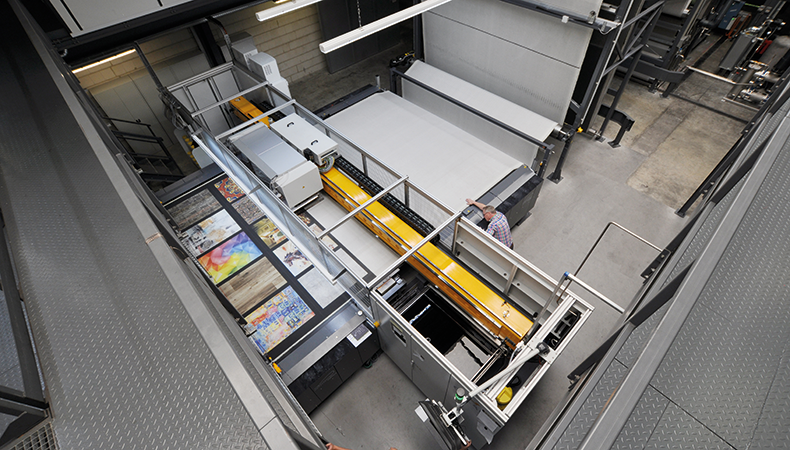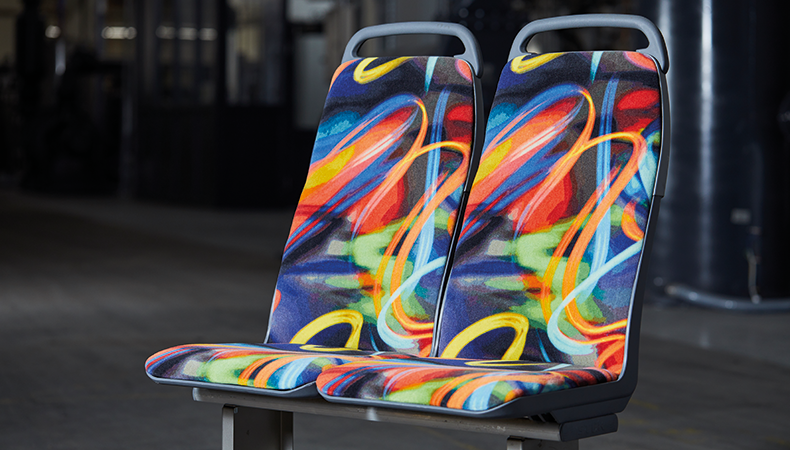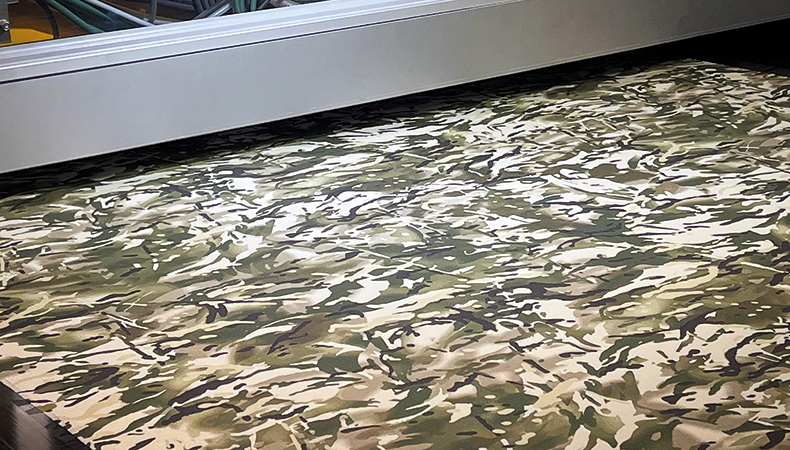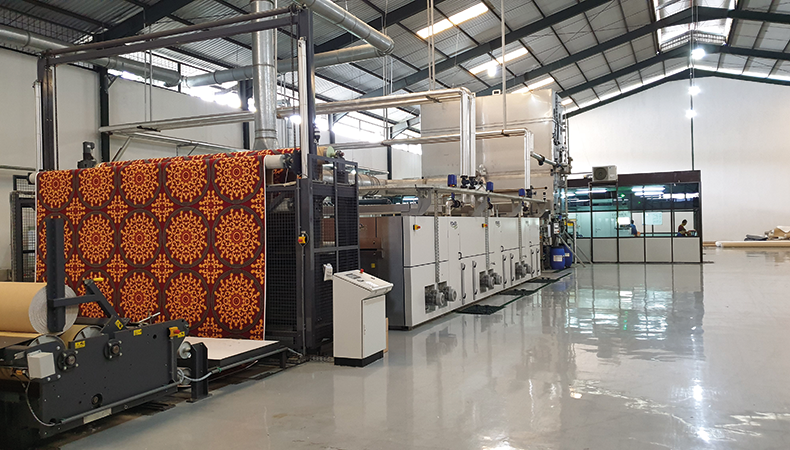Innovation in textile printing

Club FESPA Online spoke to Josef Osl at Zimmer Austria, the printing machine manufacturer, about how digital printing has revolutionised camouflage and the impact of AI on textile printing.
What are the comparative advantages/disadvantages of screen printing vs digital printing on textiles?
The passage of time has significantly changed the textile industry, which continues to evolve. Production facilities have shifted from the Western world to the Middle East and now to Asia because of increasingly stringent regulations and high labour costs. Large production volumes and low labour costs were essential to sourcing textiles at attractive prices. This aspect has not changed much. However, the rapid pace of many textile products and frequently changing fashion trends have also impacted mass production.
With rising labour costs and growing environmental awareness, along with continuously reducing batch sizes, the situation is becoming increasingly challenging for screen printing. Nevertheless, screen printing systems will continue to shape textile production, especially since there is often no technology or chemistry available today that enables digital printing for various specialty prints. Thus, digital printing and screen printing will continue to coexist in the patterning of textile substrates for many years to come.
What are the technical difficulties in printing on technical textiles or thick-pile carpets?
Fundamentally, textile printing is always linked to the types of fibres. Ultimately, the fibre determines which dye must be used. However, to advance developments, it is essential to focus on the end-product and its associated fastness requirements. There are notable differences between what a standard process can offer and what can be achieved with new process technologies.
 Colaris carpet printer. © Zimmer Austria
Colaris carpet printer. © Zimmer Austria
For voluminous textiles, it is not just the fastness requirements, such as lightfastness, washfastness, or rubfastness, that matter. The penetration of the print, wear resistance and other values are also important.
In the case of technical textiles, it is crucial to ensure that the print does not negatively impact the fundamental properties of the fibre. High tensile strength, abrasion resistance, non-interference with flame behaviour, and other critical properties must be harmonised. To meet these high demands, extensive textile expertise and close cooperation with fibre, yarn and textile producers are required. This is where Zimmer Austria sees its strengths: nearly all systems produced by Zimmer are brought to technological maturity in collaboration with the customer at the application technology centres in Kufstein and Klagenfurt, Austria.
What legal requirements do you have to follow, for household goods for example?
As a machinery manufacturer, we have limited ability to influence the use of inks directly. Our priority is to ensure that the technological processes we develop primarily use resources like water and energy efficiently, thus minimising wastewater and air emissions.
Legal requirements for the production of household textiles primarily concern the health aspects of workers in the mills and consumers, and our focus is mainly on the substances used in textile finishing. The concentration of potentially harmful chemicals must not exceed legal limits, which is fundamentally ensured by various standards and labels. Naturally, appropriate control measures and audits must be in place, including regular inspections of production facilities and final products.
 Technical textiles require the harmonisation of strength, abrasion-resistance and fire regulations. © Zimmer Austria
Technical textiles require the harmonisation of strength, abrasion-resistance and fire regulations. © Zimmer Austria
In the past, inks were occasionally identified as problematic. However, this situation has significantly improved. Zimmer Austria does not certify inks that are considered problematic ecologically or with regards to health. Nonetheless, the use of problematic inks cannot be entirely prevented if a user decides to ignore regulations. This responsibility lies solely with the user.
Alpine European products are a mark of quality and precision – what do you think gives Austria, Switzerland and parts of Germany this competitive advantage?
Alpine products are indeed distinguished by a mark of exceptional quality. This is not merely a question of marketing in the watch industry but has also been established over the years in textile machinery manufacturing. I believe this primarily has to do with the people, who often have a sense of duty and discipline combined with an above-average capacity for innovation.
As Alpine Europeans, Swiss and Austrians are perhaps cut from the same cloth. Precision, punctuality and honesty are values that are almost instilled in us from birth. These are fundamental values embedded in our society. This approach of focusing on what's important and the dedication to doing things well probably comes from this mindset.
How has digital printing revolutionised camouflage?
Even though we believe in peace, it’s important for us to ensure that both people and equipment have the best possible camouflage for protection. If you ask someone on the street what camouflage printing is, they would probably say it's about printing patterns in colours similar to nature to help things blend in and be less visible. This is true, but there's more to it, especially in a military context.
 Colaris camouflage printing uses infrared to ensure patterns blend in to the environment at night © Zimmer Austria
Colaris camouflage printing uses infrared to ensure patterns blend in to the environment at night © Zimmer Austria
Camouflage works well during the day with nature-like patterns, but at night, extra measures are necessary. Night-time and low light conditions require the use of special equipment such as infrared cameras, night-vision goggles or thermal cameras, which detect things differently. Colours on materials react differently under these conditions, often appearing as bright spots to these devices. To avoid this, we need to print specific infrared patterns on the textiles so that they blend in with the natural environment—like soil, rocks, and vegetation—making them nearly invisible at night.
Camouflage printing has evolved since the Second World War. Initially, it was done using rotary printing, but this method had its limits, such as the repetitive patterns that could be easily spotted from above by modern equipment. With digital printing, we can create more random and natural-looking designs with the right infrared features that adapt better to the combat environment.
Zimmer Austria’s Colaris camouflage printing technology not only allows for more versatile design options but also enhances how textiles perform under infrared light, making a big difference in modern camouflage techniques.
Has artificial intelligence (AI) had any impact on your workflow or on printing/design processes?
For specific design requirements, such as a random camouflage pattern, it is already standard practice. We also use AI in pattern recognition. For instance, we can visually capture existing structures or patterns in a material and then precisely apply a digital print to these structures. In carpet mat production, for example, we also use AI to recognise the mat size, mat shape, pile structure and design, thus matching the print job from the web shop. This also includes the possibility of automated quality control. These are just a few examples of AI applications that are continuously being expanded in our company.
 The carpet print line at Zimmer Austria © Zimmer Austria
The carpet print line at Zimmer Austria © Zimmer Austria
Recognising defect patterns and assigning solution possibilities in service, as well as identifying and correcting a printing error during the printing process, are interesting ways to further automate digital printing. There are many more examples we could list, but we also want to introduce some highlights to the market at the right time and perhaps offer a few surprises.
Zimmer Austria was the first to introduce both rotary screen printers and digital printing systems… how does the firm stay ahead and innovate?
Zimmer Austria was the first to bring the rotary screen-printing machine to the market. The foundational work for this was laid back in 1951. By 1954, the first two-colour rotary screen-printing machine prototype was delivered to a customer. From 1958, these machines were made accessible to a broader market. Similarly, the digital printing at Zimmer Austria began with a prototype machine built in 1975, which was used the following year to print small carpet samples.
The real revolution came between 1976 and 1978 when the first multi-colour Chromotronic printing system was built and put into operation. This system, equipped with eight separate printing carriages and a printing width of 4,200mm, demonstrated that carpets could be patterned using valve-based jet printing technology. Starting in 1980, this technology was marketed under the brand name Chromojet, becoming synonymous with digital printing in the carpet industry. It wasn’t until around the turn of the millennium that the first digital printing machines with piezo print heads entered the market. This new nozzle technology, initially used in paper printing, was directed by Zimmer Austria with the Colaris technology in fields that remained untouched by our competition for a long time. The strength of the Colaris printing machines lies in printing textile floor coverings, as well as heavy textiles like terry goods, upholstery fabrics and textiles for the automotive industry. And last but not least in the Colaris camouflage printing technology.
 Josef Ozl, Zimmer
Josef Ozl, Zimmer
Our guiding principle has always been: ‘The niche is our market.’ We continuously explore what our customers need most and strive to create innovative solutions that address these challenges, benefiting not just one client but many.
What technology are you excited about, and think may materially affect your business in the future?
Predicting the future is always difficult, but we have several interesting projects in the works. Some of these will not only strengthen our future in textile machinery manufacturing but also offer good potential in other areas.
We will report promptly on developments and innovations from Zimmer Austria and what they could mean for our customers. Such information will come first-hand through our newsletter system and via Zimmer Austria on LinkedIn. Follow us to be among the first to learn about them.
Become a FESPA member to continue reading
To read more and access exclusive content on the Club FESPA portal, please contact your Local Association. If you are not a current member, please enquire here. If there is no FESPA Association in your country, you can join FESPA Direct. Once you become a FESPA member, you can gain access to the Club FESPA Portal.
Recent news

Regulation guidance: Corporate Sustainability Reporting Directive
The Corporate Sustainability Reporting Directive (CSRD) is now in effect, but with further changes on the horizon, what does it mean for printers? Sustainability consultant Rachel England outlines everything you need to know and talks to Apigraf about how your business may be affected.

Web-to-print design: Canva versus Kittl
We look at popular design packages Canva and Kittl to determine how they compare regarding graphic design and print on demand.

FESPA in South Africa: the print skills to thrive
Printing SA’s Career Day inspired young Cape Town learners to explore printing and packaging careers.

The rise of Chinese printers
Chinese printing companies are on the rise, and have their eyes set on the UK and EU marketplace. Some have made an instant impact; others are running into issues with maintenance and language barriers. What does the future hold for Chinese printing firms, and how can you navigate working with them?